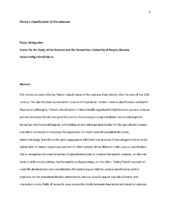| dc.description.abstract | This article considers Charles Peirce’s classification of the sciences from shortly after the turn of the 20th Century. The classification has two main sources of inspiration: Comte’s science classification and Kant’s theoretical philosophy. Peirce’s classification, like that of Comte, is hierarchically organised in that the more general and abstract sciences provide principles for the less general and more concrete sciences. However, Peirce includes and assigns a superordinate role to philosophical disciplines which analyse and provide logical, methodological and ontological principles for the specialised sciences, and which are based on everyday life experience. Moreover, Peirce recognises two main branches of specialised empirical science: the natural sciences, on the one hand, and the social sciences, the humanities and psychology, on the other. While both branches share logical and methodological principles, they are based on different ontological principles in studying physical nature and the human mind and its products, respectively. Peirce’s most basic philosophical discipline, phenomenology, transforms his early engagement with Kant and analyses three categories taken to be universal in all human experience and which inform several of the divisions in his science classification. Peirce’s classification of aesthetics, ethics, logic as normative sub-disciplines of philosophy may be seen as due to his philosophical pragmatism. Yet, given his pragmatism, his more overarching division between theoretical (philosophical and specialised) sciences and practical sciences may be seen as problematic. Taking Peirce’s historical account of scientific developments into consideration, however, this article argues that his science classification and its emphasis on the interdependencies between the sciences could be seen as sustaining and supporting interdisciplinarity and interaction across fields of research, even across the divide between theoretical and practical sciences. | en_US |
